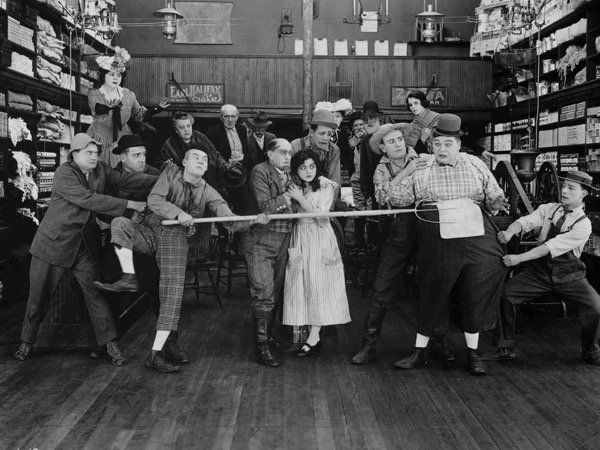THE BUTCHER BOY
Roscoe Arbuckle (US 1917)
Few centennials commemorate events as nonchalant as Buster Keaton’s arrival on the screen. “I was walking down Broadway – down along Eighth or some place – and I met an old vaudevillian [Lou Anger, later Keaton’s manager] and he was with Roscoe (Fatty) Arbuckle … And Roscoe asked me if I had ever been in a motion picture, and I said no I hadn’t even been in a studio. And he said, well come on down to the studio Monday and do a scene with me or two and see how you like it.”
Keaton went on down, and liked it well enough to pull out, there and then, from a $250-a-week contract with the Shuberts’ upcoming Passing Show of 1917, and sign with Arbuckle for $140 a week. The technology of the camera enthralled him, while his mastery of stagecraft (he had been focal in his family’s vaudeville act for most of his 21 years) gave him an instant understanding of mise-en-scène and mise-en-shot for the screen. “He lived in the camera,” Arbuckle later recalled.
His debut film The Butcher Boy was shot in the first week of April 1917. Arbuckle pictures followed a fairly consistent format. A distinctive setting – garage, bakery, hospital, music hall, Coney Island; here a general store with butchery counter – was established and then exploited to provide as many comic-strip gags and excuses for physical assault as possible. The comic possibilities of the chosen setting were generally exhausted by the end of the first reel, whereupon the second would embark on a new, more-or-less related anecdote – in this case, rival efforts to abduct the heroine from her finishing school. The rivals, Arbuckle and his energetic but unsubtle 23-year-old comedian nephew Al St. John, are disguised as schoolgirls – the corpulent Arbuckle in dainty Pickford mode. In this reel, Keaton has a secondary role as an accomplice to St. John, but still finds scope for two memorable acrobatic falls.
His principal scene comes in the first reel and lasts some 3½ minutes. He enters, walking away from the camera, in his rube overalls and – already – familiar flat hat. He toys with a bystanding crate of brooms (a regular feature of the Keaton stage set-up) and surreptitiously samples the molasses barrel. Moving over to the counter, he asks Arbuckle for a can of molasses – a simple request which escalates to a progression of mishaps, climaxing with Buster inextricably adhered to the floor and Arbuckle battling to extricate him. This molasses scene was evidently filmed in only two shots: the first, though now interrupted with cutaways and titles, of 31 seconds; the second, with Buster stuck in the molasses, in 76 seconds, with a single cutaway to a close-up of Buster’s feet. The sequence is not only remarkable for the impeccable comic partnership of Arbuckle and Keaton on their first day together, but for its contrast with the slapstick frenzy of the rest of the film. For these few minutes, Keaton imposes his own pace and poise. Buster had definitively arrived.
David Robinson



 Italiano
Italiano